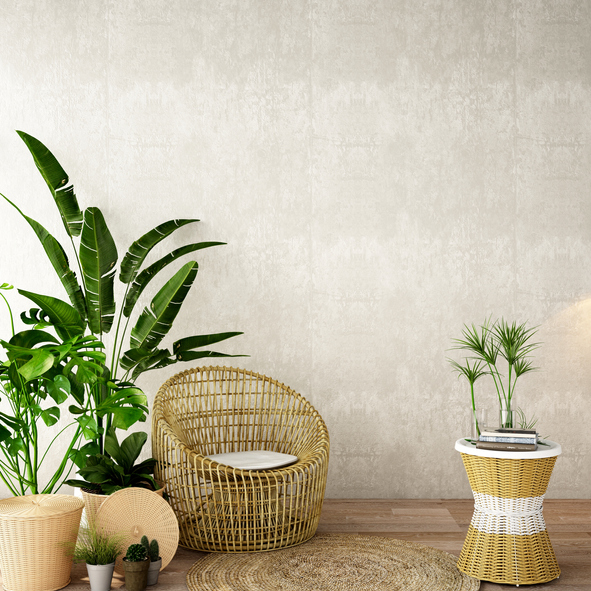
If you’re looking for a new way to decorate your home, give indoor plants a try. This luscious greenery is a great way to enhance any room, and they’ve also shown to offer a variety of health benefits, too. Read on to find out everything you need to know for happy, healthy indoor plants that will improve your space and your life.
The Benefits of Indoor Plants
Having plants inside your home not only adds a beautiful, decorative touch, but there are also plenty of other impressive benefits that these living things provide. Plants naturally filter the air, meaning your interior air will be cleaner and healthier to breathe. Certain plants may also help reduce the symptoms of allergies thanks to their air-filtering properties. It’s also been shown that having houseplants can improve your mood. When you have greenery and living things in your home, it allows you to bring the beauty of nature indoors. Even if you live in an urban setting, you can enjoy a bit of nature through houseplants. Placing plants in a home office or bedroom can instill a sense of calm, creating a more peaceful space to enjoy along with a boosted mood. Moving? Don’t forget to take your plants with you!
Using Houseplants as Decoration
Not only will having a few indoor plants improve your mood and quite possibly improve your health, but they’re also a beautiful way to decorate a room. You can use plants to brighten up a small room or place them in a windowsill to breathe new life into a kitchen or bathroom. Succulents add instant visual interest practically anywhere you place them thanks to their unique shapes and styles. Crawling vines are a beautiful, easy way to add greenery anywhere you like and require very little maintenance. Place a row of potted herbs in a kitchen windowsill for a charming touch that doubles as a delicious addition to your favorite meals.
Plants for Each Room
If you’re not sure which plants will look best in your home, here are a few suggestions to add plants to each room:
Explore the variety of indoor plants available to help you choose the perfect option for your home. Most houseplants are mostly green however, some may bloom or feature vibrant colors like pink, red, and yellow to add a fresh pop of color to any space.
Safe Indoor Plants for Dogs and Kids
Certain plants may be toxic if ingested, and they can be particularly dangerous to pets. If you have cats, dogs, or kids in the home, it’s important to choose indoor plants that are safe. Look for nontoxic plants like spider plants or trailing jade. These green houseplants are lovely to look at, and they’re also safe if Fido happens to take a bite. Do some research to find out which indoor plants are pet-proof and childproof in terms of safety. There are plenty of indoor plants that you can enjoy while being perfectly safe for little hands and curious pets. Other examples of safe indoor plants for dogs, cats, and kids include the Christmas cactus, parlor palm, mini orchid, and wax plant.
Plants That Need Less Care: Tips and Tricks
If you have a busy lifestyle, you might not have time to fuss over your indoor plants. Look for plants that require less care so you can enjoy their beauty without a whole lot of fuss. Pothos is one of the easiest plants to care for since it needs little watering and minimal light. Here are some other examples of plants that are tough to kill along with some simple care tips:
The key to any healthy plant is to find the perfect balance of light, water, and nutrients. Research a few different houseplants and choose some based on where you live, the climate, and how much light your home gets throughout the day. Some people believe that talking to your plants or playing music for them can help them thrive. Overall, it’s more about the lighting and the spot where you place them that dictates how well they grow.
Houseplants for Health Reasons
Plants can boost your mood and may actually play a role in improving health, too. Certain indoor plants, such as the snake plant and spider plant, are well-known for filtering the air and creating a cleaner environment indoors. Plants like English ivy can actually filter out mold spores, making them a perfect choice if you suffer from allergies. When it comes to boosting your mood, try an aromatic indoor plant like lavender that emits a beautiful, pleasant fragrance. Simply having greenery around can make you feel more relaxed, so enjoy a houseplant in your favorite reading spot or meditation spot.
Other Alternatives: Plastic Plants
If you don’t have time to care for houseplants, plastic plants can be a great alternative. Today’s plastic plants are more realistic than ever before, which means you can enjoy their beauty without all of the extra watering. Try a plastic tropical plant in a sunny living area. You can place a potted plastic plant on your desk in a home office or enjoy a few placed along a windowsill in the bathroom. Just be aware that plastic plants need to be dusted and cleaned to avoid triggering allergies or adding irritants to the air in your home. You can easily swap out plastic plants to fit with the season or with your changing décor.
Indoor Plants Dos and Don’ts
Now that you know more about the benefits of indoor plants, here are a few helpful do’s and don’ts:
Do:
Don’t:
Need tips on moving your plants long distance? Check out this article!
______________________________________________________________________________
Brought to you by Guest Author Lorena Romo, Content Marketing for porch.com.
TJC Real Estate & Management Services • 303.324.6988 • info@tjcrealestate.com
Your Neighborhood Realtors® Since 2005
© 2019
Originally posted on Porch.com on May 28, 2020
© 2024 TJC Real Estate. All rights reserved. Privacy Policy | Terms of Use | Website by Distill